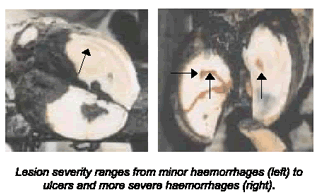How healthy are your cows’ feet? Sole lesions are a leading cause of lameness in dairy cattle, but are difficult to see except during hoof trimming. The next time the hoof trimmer comes, observe how many of your cows are affected by sole lesions. The numbers might surprise you.
Over the past year we have been visiting farms in the Fraser Valley to determine the extent of this problem, and also to find out what factors make cows more vulnerable to sole lesions. In this article we will tell you more about sole lesions and highlight some of the results of our recent research.
Sole lesions range in severity from minor bruising to severe ulcers (see photos). Lesions are signs of inner-tissue damage in the hoof that can lead to diminished cow comfort and production losses. Injuries can be present for up to two months before lesions are visible on the surface of the hoof. Until recently, most available information on the incidence of this condition was only for European dairy herds.
Results from our study on 20 Fraser Valley dariy herds indicate that the problem is wide spread in this region (see Figure 1).
During the observations at hoof trimming, we recorded the number, severity, and location of lesions in the claws of 624 Holstein cows. Lesions were found in cows from all herds. On average per herd, 85.7% of the cows had at least one lesion. When focusing only on severe hemorrhages and ulcers, the average percentage of cows affected per herd was 34.9%. This is more than double the percentage of animals affected by hairy heel wart on the same farms – a condition often cited by producers as a significant problem.

Although sole lesions were found on every farm, some cows were more likely than others to have lesions. In particular, cows were more likely to have lesions if they had a low body condition score. Cows early in their first lactation were also at greater risk for lesions, as were older cows in mid to late lactation.
Improved management for these more vulnerable cows may help reduce these injuries. For example, cows in their first lactation will likely benefit from special care during the transition phase and in early lactation. Attention to diet and access to suitable areas for rest are especially important at this stage. Mixing with older cows and overstocking might be especially risky for these animals.
In addition to these cow factors, we also found that some farms had more problems than others. We found that cows on farms with the following characteristics were more at risk for developing sole lesions: high steps, computer grain feeders, automatic alley scrapers, imperfections in concrete floors such as holes or large cracks.

Farms with steps 10 cm or higher tended to have more lesions per cow than those with lower steps. Those using computer grain feeders had more lesions per cow than farms with total mixed rations, especially when cows were allowed to consume their daily concentrate allotment in fewer than six feedings. Farms using automatic alley scrapers to remove manure from alleys had more severe lesions than farms utilizing flush or tractor-scraper methods. More severe lesions were also associated with farms that had holes or large cracks in the concrete flooring.
The link between feeding methods and sole lesions is not surprising. Diets rich in concentrates put cows at greater risk for ruminal acidosis. This in turn leads to laminitis, which weakens the sole and makes injuries more likely. Reducing the proportion of concentrates in the diet, and spreading the intake of concentrates more evenly across the day will help reduce this risk. However, attention to diet needs to go hand in hand with attention to the cows’ physical environment, especially the flooring. Flooring imperfections obstacles make hoof injuries more likely, so facilities need to be designed and maintained with this in mind. If physical problems in your barn cannot be fixed, take special care in moving cows, as injuries are most likely to occur when cows are being rushed.
We would like to express our appreciation to the producers and hoof trimmers who participated in this study. We would also like to thank the dairy industry for their support of this research, through funding to the Animal Welfare Program by the Dairy Farmers of Canada, the BC Dairy Foundation, the Cattle Industry Development Council, Westgen, members of the BCVMA and many others listed at the UBC Animal Welfare Program
This article is based on thesis research of MSc student Erin Bell. Dan Weary is Associate Professor in the Animal Welfare Program and can be contacted at danweary@interchange.ubc.ca.
